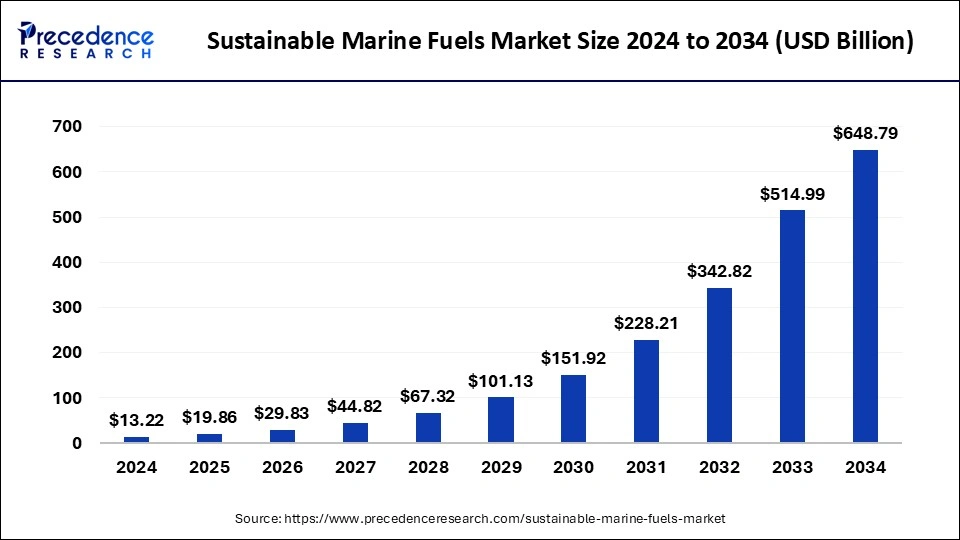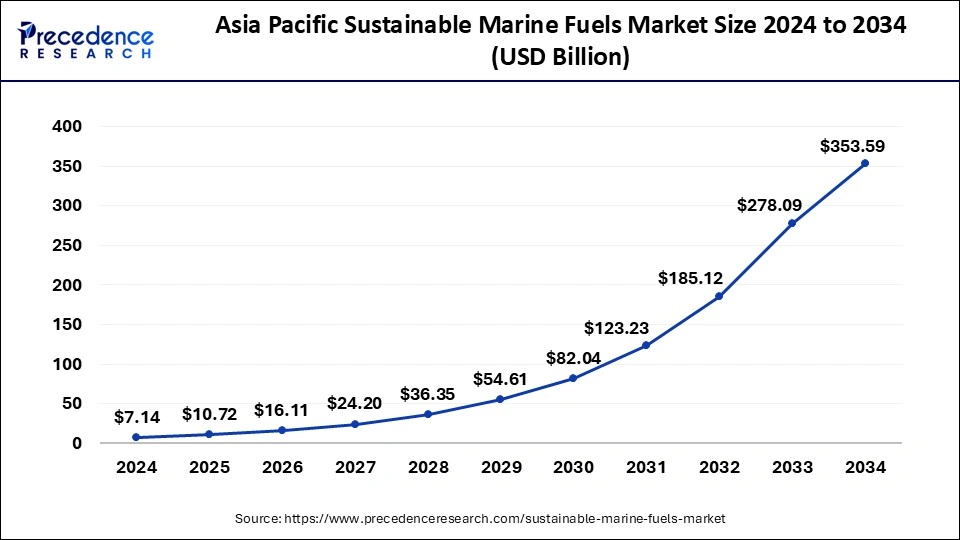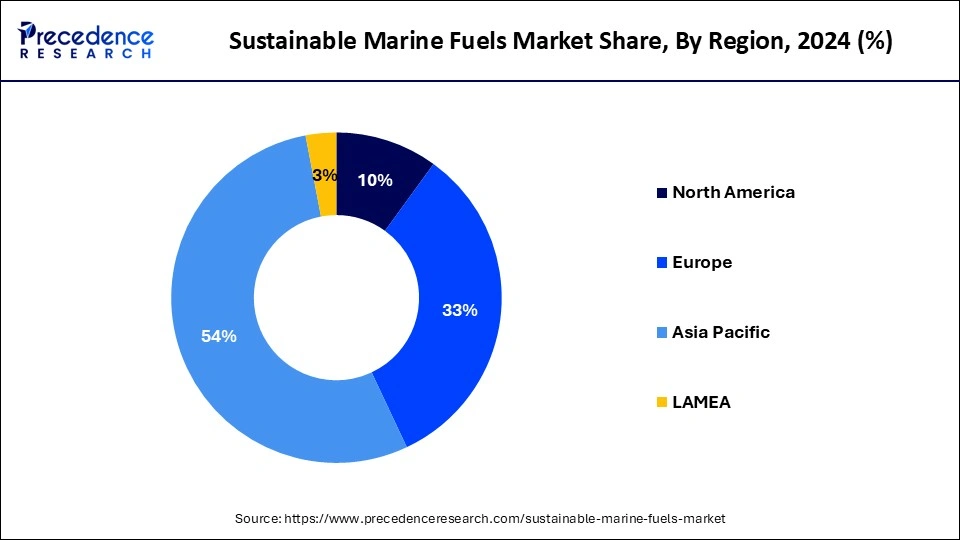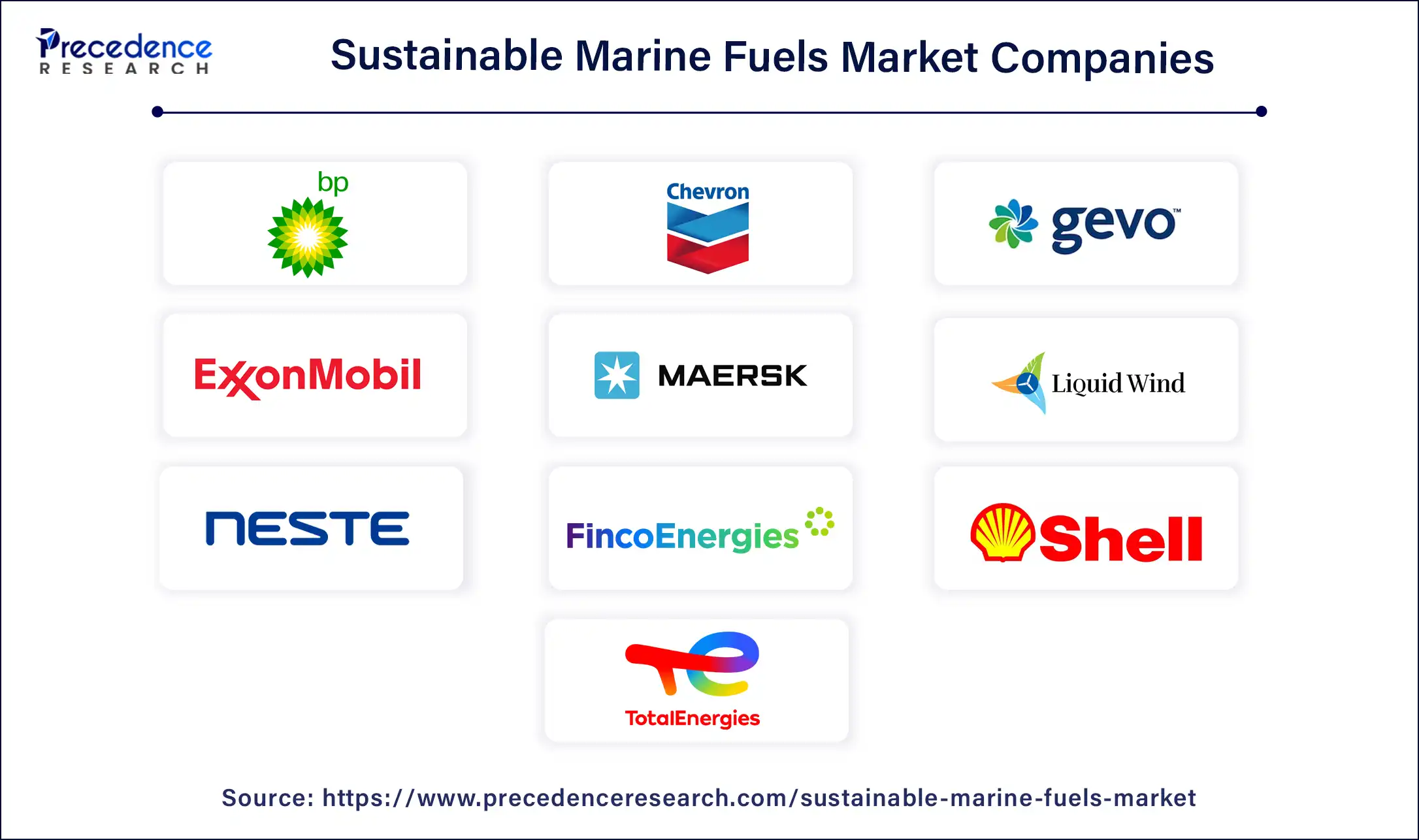November 2024
The global sustainable marine fuels market size is calculated at USD 19.86 billion in 2025 and is forecasted to reach around USD 648.79 billion by 2034, accelerating at a CAGR of 47.60% from 2025 to 2034. The Asia Pacific sustainable marine fuels market size surpassed USD 10.72 billion in 2025 and is expanding at a CAGR of 47.73% during the forecast period. The market sizing and forecasts are revenue-based (USD Million/Billion), with 2024 as the base year.
The global sustainable marine fuels market size was estimated at USD 13.22 billion in 2024 and is predicted to increase from USD 19.86 billion in 2025 to approximately USD 648.79 billion by 2034, expanding at a CAGR of 47.60% from 2025 to 2034. Increasing awareness about environmental changes due to high emission of carbon and to combat this, supportive regulatory policies by authorities for clean energy and low carbon use fuelling the market growth exceptionally across the globe.

The Asia-Pacific embedded finance market size surpassed USD 7.14 billion in 2024 and is projected to attain around USD 353.59 billion by 2034, poised to grow at a CAGR of 47.73% from 2025 to 2034.

Asia Pacific held the largest share of the sustainable marine fuels market in 2024. The growth of this region includes several factors, such as developing economies like China, India, Japan, and Korea, which are the major countries located in the Asia Pacific region. Due to the fastest-growing nature of these regions, maritime transportation activities have seen a surge in the Asian region, making it a dominant region of the market. Private institutions and governments in the Asia Pacific region have shown a responsible and proactive approach to the practice of transportation using environmentally sustainable fuels like biofuels and hydrogen fuels for cleaner energy aims worldwide.
Embracing the stringent regulations set by authorities like the international maritime organization Asia Pacific creates a conducive environment for a sustainable marine fuels market to foster notably. With the rising emphasis on cleaner energy, Asian consumers and major players are showing interest in companies that Favor green practices over conventional methods of using fuels. Such an eco-friendly preference by consumers led shipping enterprises to adopt sustainable marine fuels in the Asian region, further fostering the growth of the sustainable marine fuels market globally.

Europe, on the other hand, is experiencing a notable growth rate in the sustainable marine fuels market. The growth factor of this region is stringent compliance set by the European government, which aims to reduce greenhouse gas-GHG by more than 30% by the end of 2050, which is produced by the maritime industry and activities in the marine shipment market within the European region.
The sustainable marine fuels market refers to the industry that revolves around providing climate-friendly and sustainable marine fuels; it further involves the distribution and utilization of these fuels. The global market is expected to grow significantly with rising CAGR during the foreseeable period. The market is emerging within the maritime sector. Maritime transportation holds a larger margin in the transportation sector. Thus, marine fuels are designed to support climate by using hydrogen fuels. Synthetic fuels and biofuels. These fuels help reduce the emission of greenhouse gases to mitigate the adverse effects of the fuels used by marine transportation.
The major key factors driving the sustainable marine fuels market include stringent rules for decarbonization, partnerships and collaborations between key industry players and government, and ongoing research and development to improve the efficiency of marine fuels, which in turn helps in reducing the toxic byproducts from marine fuels. Since the anticipation for cleaner energy resources has risen, the maritime industry has grown exponentially in terms of producing environmentally friendly fuels that have lower sulfur content. Thus, due to such initiatives and mandate rules for cleaner energy, the sustainable marine fuels market is poised to grow globally.
| Report Coverage | Details |
| Market Size by 2034 |
USD 648.79 Billion |
| Market Size in 2025 | USD 19.86 Billion |
| Growth Rate from 2025 to 2034 | CAGR of 47.60% |
| Largest Market | Asia Pacific |
| Base Year | 2024 |
| Forecast Period | 2025 to 2034 |
| Segments Covered | Type, Application, and Regions |
| Regions Covered | North America, Europe, Asia-Pacific, Latin America, and Middle East & Africa |
Initiatives to mitigate carbon emission
The major driving factor for the sustainable marine fuels market is the increasing prevalence of government initiatives while collaborating with corporate industries and private institutions to decarbonize the environment due to the shipping activities, which in turn fuels the use of sustainable fuels for the maritime market broadly. Initiatives like eco-port policies and green shipping encourage shipowners to incorporate a fuel that is climate-friendly throughout the shipping process.
Green shipping practices must be in alignment with government policies to contribute to the wider adoption of sustainable marine fuels. For instance, the International Maritime Organization has been realising the urgency of reducing carbon emissions; to achieve this goal, they mandate an emission reduction of about 50% for every vessel up to 2050. To comply with this mandate, the major regions, such as the United States, Japan, and the United Kingdom, have decided on a goal for net-zero carbon emission from shipping activities within the same time frame of 2050.
Challenge to build economic infrastructure
The major challenging factor affecting the growth of the sustainable marine fuels market is economic volatility due to constantly fluctuating market prices when compared to conventional fossil fuels. Fossil fuels have a comparatively low production rate due to their establishment in the market for so long. Sustainable marine fuels like synthetic fuels, hydrogenated fuels, and biofuels are often derived from high-cost production. Such cost differences may pose a challenge to sustainable fuel uses within the maritime industry.
To produce sustainable marine fuels, various complex manufacturing processes are involved, which also need cutting-edge technologies altogether, which in turn is going to increase overall expenses. To overcome this, a substantial amount of investment will be needed with collaboration within regions across the globe, technically sound infrastructure to generate a sufficient amount of biofuels, need to increase vessel capacity for transportation and storage again assert a financial burden which eventually hinders a mass adoption of marine fuels across the globe.
Collaboration of major players aims for decarbonization
A significant opportunity for the sustainable marine fuels market would be investments in research and developments for marine fuels aiming to reduce carbon emissions; for instance, the US Energy Department supports the Bioenergy Technologies Office –BETO for investment in research and development to achieve the target of low-and-net-zero-carbon sustainable fuels used for marine transportation. According to the statistics, nearly 3% of greenhouse gases are emitted by the maritime industry, including massive recreational boats and small ships.
BETO works efficiently under the guidance and expertise of the U.S. Department of Energy while approaching strategic plans to build a stable economy for sustainable marine fuel production and its efficient use in the maritime market. Furthermore, due to such continued efforts, the maritime industry has developed a fuel that has the potential to emit nearly zero carbon /GHG as a residue. Such fuels can be bio-methanol, lignin-alcohol mixes, and bio-based natural gases. These gases are extremely helpful in bringing decarbonization efforts into reality. It may only take a minor change, such as mechanical modifications and innovative engine designs for ships and large sailing boats.
The hydrogen segment accounted for the largest market share in 2024 and thus dominated the sustainable marine fuels market globally. The growth of this segment is attributed to the fact that when hydrogen is used as a fuel, it does not produce any residue or trails behind it in any form of toxic emission, which is suitable for reducing the carbon emission by the maritime industry and thus, becoming a popular choice for shipowners and manufacturers from the maritime market as it also complies with stringent regulatory rules set by authorities to meet the low carbon emission target.
Since hydrogen is a highly stable molecule, it does not react as explosively as compared to other fuels derived from the conventional crude oil method. It is also versatile in nature as it can be derived from many processes with different forms. For instance, green hydrogen can be produced in large amounts from renewable energy sources. Hydrogen has a highly dense energy, making it a potential energy carrier, which in turn can drive the engines of large marine ships. Moreover, ongoing technological advancements and their applications in the maritime industry to separate the hydrogen so that it can be used as a sustainable marine fuel are promoting this hydrogen segment globally.
The ferries segment dominated the sustainable marine fuels market in 2024. A ferry is a small or large watercraft vehicle or vessel that carries passengers or sometimes cargo, vehicles depending upon the demand and type of the ferry, over a short, fixed distance with a pre-decided route in the water or ocean.
Ferry transportation has risen in recent years due to the comfort and luxury of riding by the water route. It is also less expensive than other transportation modes to reach their destination. Moreover, advancements in vessels that carry passengers encompass various entertainment sources and safety features, which further drive the ferry segment’s growth. Hence, manufacturers and ferry owners need to comply with stringent regulatory rules for low carbon emissions in the maritime industry and practice sustainable fuel uses for ferries to avoid violation of rules.

By Type
By Application
By Geography
For inquiries regarding discounts, bulk purchases, or customization requests, please contact us at sales@precedenceresearch.com
No cookie-cutter, only authentic analysis – take the 1st step to become a Precedence Research client
November 2024
October 2024
October 2024
July 2024